How to choose quality LED bulbs, with a good colour rendering
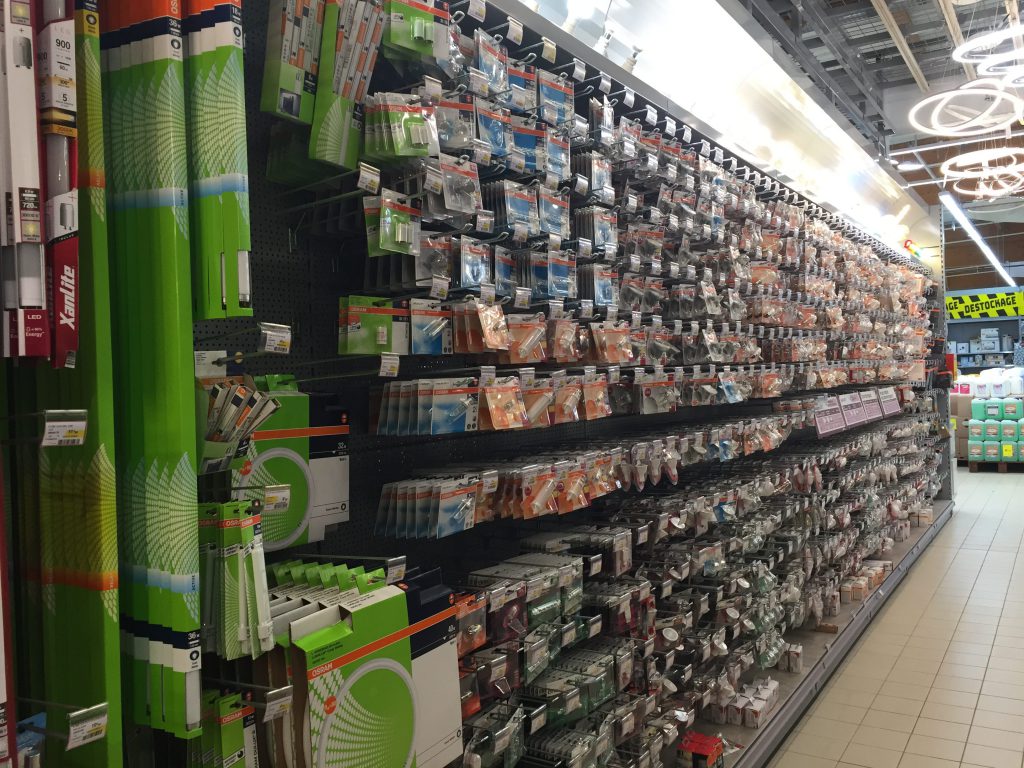
If you read our previous pages (bulb technologies), you will know that LED bulbs can now be a very good – and often the best – solution.
But if you choose a LED randomly in a store shelf, you risk being disappointed. And if you invested hours and hundreds of pounds to choose great luminaries, you do not want bulbs that cast a pallid light upon your carefully selected decorations. These tips can help you find LEDs that enhance your lighting fixture, your room and the objects you have put together.
We have already explained why the amount of lumen emitted, and the color rendering are essential. The quality of the cooling of the LED is also essential to preserve its life. Let us come back to each of these points.
1. The power of the luminous flux
This power is measured in lumen. This is the quantity of light that comes out of your bulb, wherever it goes.
At equal illumination of each square centimeter (measured in lux), you will need more lumen if your LED illuminates widely (such as for example a bulb that illuminates an entire room from a distance), than if it is a focused lighting (like for example a spot). If you add a shade, or if you opt for an opaque bulb, the light will be in addition attenuated. Today we find LED lights for spots that provide extremely powerful lighting, provided of course they are well cooled. On the other hand, few general purpose LED bulbs (imitating the traditional incandescent bulb for diffuse lighting) provide today enough power to illuminate a whole piece on their own (it is true for many modern bulbs). But the technology is constantly improving, and some manufacturers propose today some LED bulbs close to 1000 lumen, which starts to be satisfactory (provided again that they are cooled sufficiently, see below).
2. Color rendering
For us at Vraiment Beau, and for you if you are looking for a beautiful lighting that enhances your room, this is an essential point that is often hushed by manufacturers of cheap bulbs. What is it about?
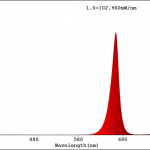
A LED is a semiconductor (a “chip”) that emits a single colour, so with a very narrow light spectrum: about 25 nanometers wide, about a tenth of the visible light spectrum. The first LEDs were blue, then appeared red and green LEDs. On the right side, is the typical spectrum of a red LED.
Bulb manufacturers have therefore added a layer of phosphor above the semiconductor (now typically a blue LED), which captures some of the light from the LED, then heats and re-emits the yellow and red light (warm tones). The blue of the LED plus the yellow and the red of the phosphor “mix” into an average colour closer to what one wants (generally a colour temperature between 2500 and 4000 Kelvin). The technique is getting more sophisticated every day and manufacturers keep develop more effective components: for instance “remote” phosphors, blends of phosphors of different colours, exotic metals added to the phosphor. The technique also improves the thickness of the phosphor layer, its regularity, or size or even the shape of the phosphor grains.
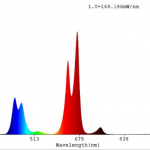
All these innovations add to the manufacturing cost, but are responsible for the fast progress in performance and quality of LED technologies. For instance, the colour of low quality LEDs can vary significantly depending on the lighting angle (if the phosphor layer is not homogeneous); the power of the LED will also change according to the technologies chosen; and even the ability of the bulb to keep a constant colour as it ages will depend on these choices.
But even more importantly the light spectrum can vary considerably: in the image on the right, we clearly see the blue peak of the LED, and the red curve of the phosphorescence. An LED with this spectrum will emit a white average light with the same temperature as a better quality LED, but with a spectrum “full of holes”.
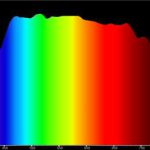
The quality of the light depends on the coverage of this spectrum by the LED. Daylight has a regular and uniform spectrum. If you replace it with a light that has too many holes in its spectrum, the colours of your paintings and the materials of your decorative items will suffer. The fine differences between colours will fade, some details will disappear, shimmer effects will be erased because the light frequencies that make them “vibrate” will be missing in the light spectrum that illuminates the room.
A measure of this quality of the emission spectrum is the CRI (Color Rendering Index). A CRI of 100 corresponds to the maximum quality, 80 is the minimum allowed by the European regulation, and the threshold for a “good” quality is 95.
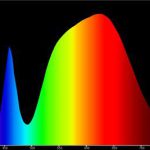
The quality bulbs are the result of a lot of effort on the part of the manufacturers and are composed of quality materials. Their cost is therefore much higher than that of low-end LED bulbs and they also consume more energy for the same number of lumens (because more of the energy is “spent” on colours on the edges of the spectrum, where the yield in lumen is less – see the definition of the lumen), but the game is worth the effort. This is obviously even more true if you want to illuminate works of art, clothes or products like fruit or meat in a shop. On the right, the spectrum of an LED of acceptable quality: we can still see the blue peak of the LED and there is a hole on the left of the phosphorescence curve, but the coverage of the spectrum begins to suffice for a good rendering (CRI about 90).
We should also mention that the meaning of the CRI is limited: the CRI (Ra) measures the average rendering of only eight colours of the spectrum (the low saturation colours R1 to R8). In the case illustrated below, this average is 82. Spectrum analyses usually provide 7 other colours that do not count for the CRI but which provide complementary information: R9 to R12 which measure the rendering of 4 saturated colours (red, yellow, green and blue), plus R13 to R15 which measure the rendering of 3 colours of special interest (R13 and R15 for two variations of skin colour, and R14 for a colour of vegetation).
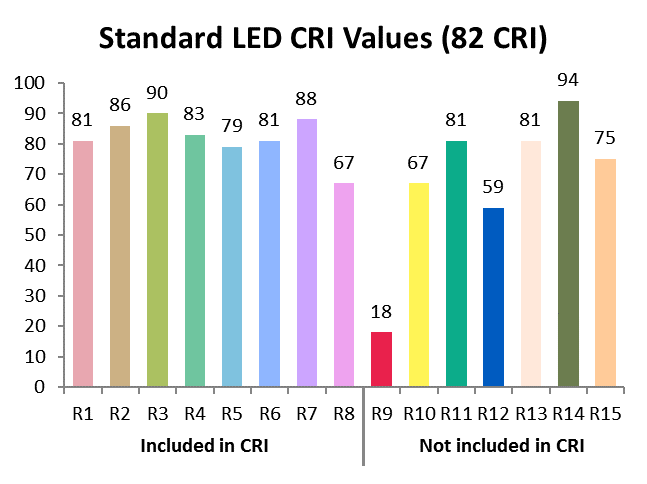
One measure is emerging for demanding professional applications, the Rf, which measures the rendering of 99 colours. You can also find in some technical documentations the FSIC, which is the FSI (Full Spectrum Index) reduced to a scale of 0 to 100 (100 being the maximum), and which measures more accurately the homogeneity of the light spectrum.
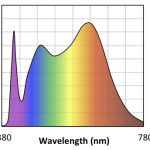
High-end LED manufacturers are now starting to offer LEDs with very impressive light spectra for professional applications, and more and more for demanding amateurs. This is the case, for example, of Soraa and Carus, of which we offer a selection of high quality LED bulbs in our bulbs category.
3. RGB LED bulbs
You will find bulbs whose colour is adjustable to cover a good part of the visual spectrum. You can light your room in red, green, blue or white, or even vary the colour with your music. They are often connectable to an IPhone or to some other remote control system. It is obviously very entertaining, and sometimes very practical. It should be noted, however, that these colours are achieved with three LEDs that each emit a primary colour: blue, green, red. Depending on the setting of each, the colours blend together to produce a composite colour. This is the case for example of Hue bulbs from Philips.
This means that the spectrum emitted by the lamp is reduced to three peaks, each corresponding to one LED. Under the principles outlined above, the quality of light and colour rendering therefore remains very poor: the light will appear “flat”, details on tables will disappear and some colours will disappear completely even if you set your bulb to what appears to be a “neutral” white colour.
Our view is therefore that these LED bulbs are quite practical for your movie theater or for the party of your children, but you should definitely choose something else to illuminate your Turners.
4. Dimmable LED bulbs
Finally, we should mention the “dimmable” LEDs, that is to say, compatible with a dimmer. Here too, there are several kinds.
The simplest model can reduce the intensity of light, with a switch or a remote control connected to a special box, the “Driver” of the LED (several technologies exist, 0-10V DC control, 1-10V control DC or the Dali control), or if the LED is labeled as “dimmable”, with the dimmer you used for your incandescent lamps. Note again that nothing is free, and that you will get a much more efficient variation with a “driver” designed with a quality dimmer.
If you have carefully chosen the colour temperature you want, you might then want to check that it does not vary too much when you adjust the intensity.
Other models now are proposed that adjust the colour temperature. This time, the bulb contains several LEDs, each with its own colour temperature. The driver (always the same), will control the intensity of the different LEDs to reproduce the colour you ask. Note this time that if each individual LED is of good quality (so with an extended spectrum and a good colour rendering), you can get a very good quality of light with this system.
* * *
LEDs are now essential in the world of lighting. However, if the quality of their light is extremely variable, we now find very powerful LEDs that emit a superb light. They are more expensive than low-end LEDs, but they will last longer, and you will be amazed by the beauty they cast on your rooms and your decorations. Do not hesitate to call us if you need advice.
* * *
You can find further guidance in the following page:
- Our advices to dimension your lighting and choose your fixtures: the principles of lighting design.
- Which types of bulbs you should choose, from all the technologies now on the market - fluo-compact, LEDs etc: what you need to know about bulb technologies.
- How you should choose the LED you need, depending on your room and your expectations in terms of lighting (there is more to it than what you can read on most bulb packages): our guide to choosing LED bulbs.
- Explanation of what the various lighting units mean, and how to use them: how to speak the jargon, with lux, lumen and candela!.
- Use our calculators to size your lighting according to its purpose: our lighting calculators.
- Find your way in the jungle of the various European bulb types: our simple guide to the various bulb models.
- Read our advice on why you could consider connected lighting, and how you can jump on the train without the headaches: starting with connected lighting.
You can also find below our advice to choose and install the various types of lighting you can find in our catalogue:
- suspensions, chandeliers and pendants
- Table and desk lamps
- Wall lights
- Lighting beacons for circulation areas (indoor or outdoor)









